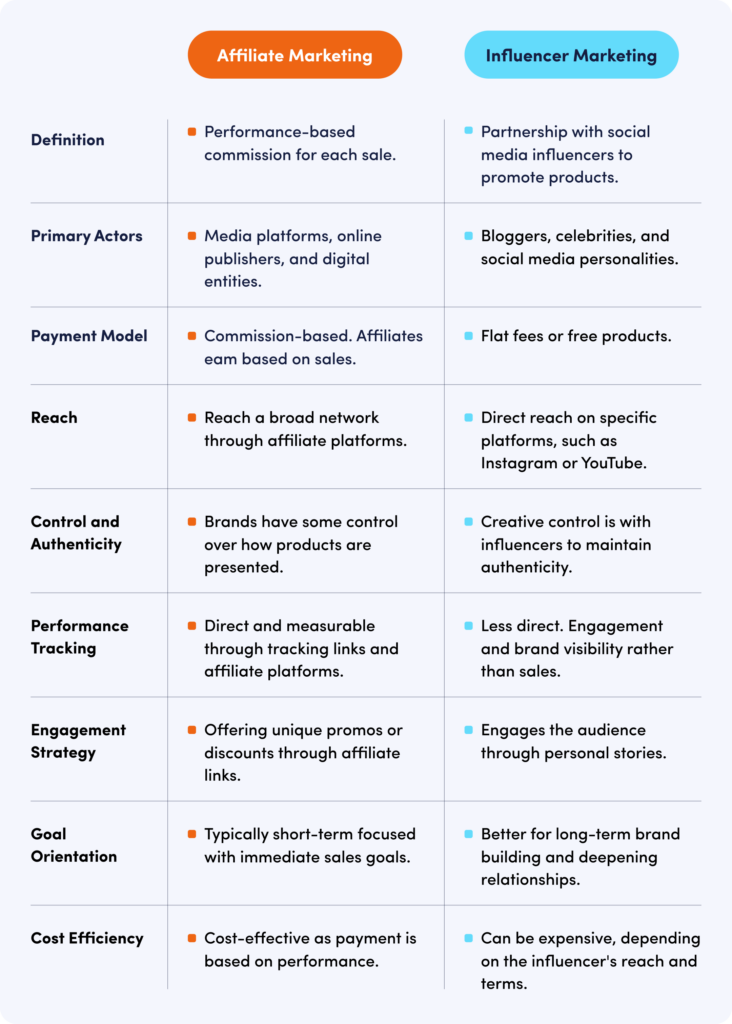Affiliate Marketing vs Influencer Marketing: How to Choose the Right Strategy for Your Brand

Some industry experts say that affiliate marketing could reach a global value of $40 billion by 2030.
Influencer marketing could be worth even more – almost $200 billion by 2032.
Clearly both types of marketing are valuable. But which gives you the best results, affiliate marketing vs influencer marketing?
There’s no simple answer. It depends on your goals, target market, and budget. In this article, we’ll explore both types of marketing in more detail and find out how to decide which is best for you.
What Is Affiliate Marketing?
Affiliate marketers are a bit like art dealers, who promote works of art without actually owning them. Instead, they take a commission on each sale.
Affiliate marketers promote other people’s products and earn a small cut from each sale. Sales are tracked through a unique affiliate link.
Think of affiliate marketing strategies as performance-based systems that tie earnings to sales conversions.
In general, affiliate marketers do the following:
- Pick the right products
- Share content with their audience
- Convert their audience into buyers.
Well-known online entrepreneur, Pat Flynn, explains how to get started with affiliate marketing strategies in this workshop:
What Is Influencer Marketing?
Influencer marketing is different.
Rather than paying commission, the brand normally pays a social media influencer directly (or gives them free products) in return for recommending their products. It’s a form of “word-of-mouth” marketing in which influencers review or endorse a product, but don’t aim to convert people into buyers.
To find out more about how influencer marketing works from several experts in the field and members of the public, check out this video:
Affiliate Marketing vs Influencer Marketing
Affiliate marketing and influencer marketing are two distinct strategies brands use to reach their target audience and drive sales, each with unique characteristics and approaches.
Affiliate marketing is a performance-based strategy where affiliates, such as media platforms, online publishers, and digital entities, earn commissions for each sale they generate. This model is cost-effective, as payments are only made based on actual sales. Brands have some control over how their products are presented, and the performance is directly measurable through tracking links and affiliate platforms. This strategy often involves offering unique promotions or discounts through affiliate links, with a typical focus on achieving immediate sales goals.
In contrast, influencer marketing involves partnering with social media influencers, including bloggers, celebrities, and social media personalities, to promote products. Influencers are given creative control to maintain authenticity, which resonates with their audience. Payment models for influencer marketing can vary, often involving flat fees or free products rather than commission-based payments. This approach allows brands to reach specific platforms directly, such as Instagram or YouTube. It is more oriented towards long-term brand building and deepening relationships with the audience through personal stories. However, performance tracking is less direct, focusing on engagement and brand visibility rather than direct sales, and it can be more expensive depending on the influencer’s reach and terms.
While affiliate marketing aims for short-term sales goals with a cost-effective and measurable approach, influencer marketing is better suited for long-term brand building, leveraging the influencer’s connection with their audience to build engagement and brand loyalty.
The table below offers a side-by-side comparison of both types of marketing.

Affiliate Marketing Pros and Cons
Benefits of affiliate marketing
- Easy to get started: Affiliate programs have a low barrier to entry. You don’t need a big ad budget or creative team.
- Increased sales and high ROI: It can seriously boost sales with high ROI, as you only pay for results.
- More web traffic to your site: Affiliate links may help improve your site’s SEO by driving more inbound traffic.
- Easy to implement: Setting up an affiliate marketing program is easy, with plenty of tools and platforms out there to help, such as Amazon Associates and ClickBank.
- Low-risk payment models: There are no upfront payments. Affiliates earn directly from the sales they generate. This makes it low risk – like only paying for a fishing trip if you actually catch some fish.
- Highly scalable: As your business grows, you can bring in more affiliates to expand reach. This flexibility takes the pressure off you to create and post more content.
Cons of affiliate marketing
- Dependency on affiliates: Your success depends on the effort and success of your affiliates. If they don’t perform too well, neither do you.
- Commission costs: You have to offer enough commission to motivate affiliates, while still ensuring you make a profit.
- Management overhead: It takes time and effort to manage relationships, track performance, and ensure affiliates have the support they need.
- Potential brand risk: If an affiliate uses spammy methods or misrepresents your brand, it can impact your reputation in a bad way.
- Managing affiliate growth: As you grow, you could find yourself managing a large network of affiliates. Affiliate marketing isn’t a “set-it and forget-it” thing. It needs regular upkeep
While affiliate marketing has some perks, it’s not without its challenges. You have to make sure you’re running a tight ship and working with the right people to make it a win-win scenario.
Influencer Marketing Pros and Cons
Benefits of influencer marketing
- Build brand awareness: Widen your reach and get more visibility, especially if the influencer’s followers align with your products.
- High ROI: Businesses often get an engagement lift, but it might be difficult to measure influencer marketing ROI.
- Cost efficiency: Generally cheaper than traditional marketing like display ads. Plus, you can adjust your budget depending on whether you’re working with big-name influencers or smaller, micro-influencers.
- Gain credibility: Influencers have their audience’s trust, which can rub off on your brand when they recommend your products.
- Versatility: No matter if you’re just starting out or running a large company, there’s likely to be an influencer out there who can help spread the word to the right people.
Cons of influencer marketing
- High upfront costs: Some influencers are expensive right from the start, charging a premium for their time and influence.
- Reputation risks: If an influencer lands in hot water or loses popularity, it could tarnish your brand by association.
- Less control over content: While it’s great to let influencers do their thing, sometimes what they create might not quite match your brand’s image or send out mixed signals.
- Hit or miss results: Unlike affiliate marketing where you pay based on performance, influencer marketing doesn’t always directly drive sales.
Key Performance Metrics Comparison
Many brands start out with both affiliate and influencer marketing, then track key metrics to see which one works best. This way, they can double down on the most impactful.
Staying on top of your data keeps you agile. With the right data insights, you can fine-tune your campaigns for better performance. If, for instance, positive influencer marketing trends drop off for certain products, you can adapt and focus more on affiliates.
Below, we’ll look at how to measure success and which analytics to pay close attention to.
Affiliate marketing metrics
- Conversion rate: Percentage of visitors who complete a desired action (e.g., making a purchase) after clicking on an affiliate link.
- Click-through rate (CTR): Ratio of users who click compared to the total number of content viewers.
- Sales volume: Total number of sales generated.
- Average order value (AOV): Average amount spent per transaction through affiliate referrals.
- Cost per action (CPA): The cost to the brand for each completed action (e.g., sale, lead, or sign-up) through an affiliate link.
- Return on investment (ROI): Overall affiliate campaign profitability, comparing revenue generated to costs incurred.
Influencer marketing metrics
- Engagement rate: The level of interaction (likes, comments, shares) that influencer content receives from their audience.
- Reach and impressions: The number of unique users who see the influencer’s content and the total number of times the content is displayed.
- Brand awareness: Measured through metrics like brand mentions, hashtag usage, and sentiment analysis.
- Audience growth: The increase in followers or subscribers for the brand’s social media accounts as a result of influencer collaborations.
- User-generated content: The amount and quality of content created by users inspired by the influencer campaign.
- Click-through rate (CTR): Similar to affiliate marketing, this measures the effectiveness of influencer content in driving traffic to the brand’s website or landing pages.
Making the Right Choice for Your Brand
If you’re deciding between affiliate marketing vs influencer marketing, it all comes down to your brand’s goals and budget. Are you looking to ramp up sales, boost awareness, or expand your audience? Each strategy has its own pros and cons, as mentioned above, so pick one that fits your budget and aligns with your objectives.
When choosing, think beyond quick wins. Opt for something that promises sustainable growth. Ask yourself:
- Does this strategy fit into my long-term goals?
- Will it help forge lasting connections with my audience?
- Does it uphold my brand values?
- Will this strategy adapt well as market trends change?
- Can this approach integrate well with other ongoing marketing efforts?
Basically, you need to choose a marketing method that aligns with your vision for the future. Outbrain can be a valuable tool in reaching these long-term marketing objectives.
For affiliate marketing campaigns, Outbrain can help drive targeted traffic to premium content. Outbrain can also extend the reach of influencer campaigns beyond their own social media platforms.


